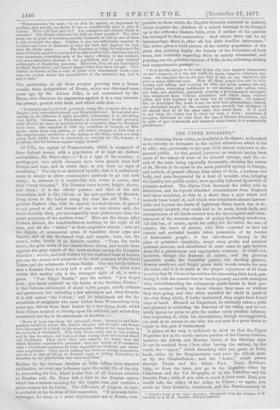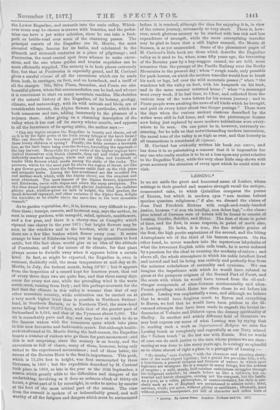THE UPPER ENGADINE.* True charming Swiss valley, so healthful in
its climate, so favoured as to scenery, so fortunate in the varied attractions which it has to offer, was, previously to the year 1858, almost unknown to the general public. At that period, however, an analysis having been made of the waters of some of its mineral springs, and the re- sult of the tests being especially favourable, showing the waters of St. Moritz to be equal to the most powerful springs in Europe, and indeed, of greater efficacy than many of them, a kurhaus was built, and soon frequented by a host of invalids, who, bringing the locality into public notice, were speedily followed by crowds of pleasure-seekers. The Alpine Club favoured the valley with its attentions, and its reports attracted mountaineers from England and other countries, so that in a short time a spot which had scarcely been heard of, and which was considered almost inacces- sible and beyond the limits of legitimate Swiss travel, was so de- terminedly invaded, that roads had to be made, hotels built, and arrangements of all kinds entered into for the reception and enter- tainment of the welcome stream of money-bestowing wanderers. All this has, of course, spoilt the valley for the artist, the man of science, the lover of nature, who little expected to find his remote and secluded haunts taken possession of by hordes of fashionable people ; it has introduced luxury in the place of primitive simplicity, swept away pretty and poetical national customs, and substituted in most cases an ugly modern dress for a picturesque and appropriate costume. It could not, however, change the features of nature, and the glorious mountain peaks, the beautiful passes, the dazzling glaciers, flowery meadows, and bright green larch woods remain for ever the same, and it is to assist in the proper enjoyment of all these beauties that M. Caviezel has written his interesting little book, pre- facing it with the remark that he has frequently met with strangers who, notwithstanding the voluminous guide-books in their pos- session, seemed hardly to know whence they came or whither they were going, and who often travelled far afield in quest of the very thing which, if better instructed, they might have found close at band. Himself an Engadiner, he naturally takes a pride and pleasure in unfolding the beauties of his valley, and lie cer- tainly -spares no pains to give the reader every possible informa- tion respecting it, while his descriptions, though unexaggerated, are such as to arouse in one who has not seen it a great desire to repair to this part of Switzerland.
A glance at the map is sufficient to show us that the Upper Engadine lies in the south-eastern portion of the Canton Grisons, between the Albula and Bernina chains of the Rhmtian Alps.
It can be reached from Chur, after leaving the railway, by two roads, the " upper," which branching into two parts at Lenz, leads, either by the Bergiinerstein and over the Albula pass, or by the Oberhalbstein ; and the " lower," which passes through Thusis and the Schyn Pass. From Northern Italy, or from the lakes, you go to the Engadine either by Chiavenna and the Val Bregaglia, or by the Valtelline and the Bernina Pass ; while if you wish to reach it from south Tirol, you would take the valley of the Adige to Tirano ; or again, you could go from Kufstcin, Innabriick, and the Nawderserberg to
* Tourist's Guide to Me Upper Engadine. Translated from the German of M Caviezel, by A. H. H. London; Edward Stanford.
the Lower Engadine, and onwards into the main valley. Which- ever route may be chosen is strewn with beauties, and the pedes- trian can have a yet wider selection, since he can take a foot- path or bridle-road over some of the charming passes. The principal resorts of the Engadine are St. Moritz, the most elevated village, famous for its baths, and celebrated in the fifteenth and sixteenth centuries as a place of pilgrimage ; and Pontresina, the most central spot from whence to make excur- sions, and the one where guides and tourist requisites can be
most efficiently supplied. The scenery is in both places extremely fine, but that at Pontresina is especially grand, and M. Caviezel gives a careful résumé of all the excursions which can be made from both, in carriages, on foot, and on horseback, and a tariff of
all the charges. Sils, Silva Plana, Samaden, and Polite are also beautiful places, where fair accommodation can be had, and whence it is convenient to start on many mountain rambles. His sketches of the natural history of the Engadine, of its botany, geology, climate, and meteorology, with its wild animals and birds, are of considerable interest, the Alpine flowers in particular, which are both numerous and rare, adding immensely to the pleasure of a sojourn there. After giving us a charming description of the valley when it has cast off its snowy winter mantle, and appears in all the luxuriance of its spring attire, the author says :-
" Can any region surpass the Engadine in beauty and charm, set off as it is by the light green of the fresh young foliage of the larch forest? Who can describe the luxuriant growth and the vivid colours of all these lovely children of spring? Finally, the fields assume a brownish hue, as the dark bents hang over the flowers, foretelling the approach of the bay harvest. Meanwhile the grey rocks of the higher regions have decked themselves with bluish clematis, deep red and violet primulas, delicately-marked saxifrages, white and rod lilies, and hundreds of tender little flowers which nestle among the clefts of the rocks The pastures, which for the most part lie above the region of forest, are like a gay flower-garden, where the frolicsome cattle feed on the rich grass and aromatic herbs. Among the last-mentioned aro the so-called Iva and mother-wort, which, with the Alpine clover, are the sweetest and most abundant. The most famous of the Alpine flowers, Alpenrosen and Edelweiss, cover wide slopes and adorn the steep precipices. The sky-blue dwarf forget-me-not, the pink glacier Androsaco, the stalkless glacier pink, whitlow-grass an inch in height, the tiled gentian, the small-flowered rapuazel, and ether varieties of the Alpine flora, delight the traveller, as he climbs above the snow-line to the bare mountain summit."
As to garden vegetables, &c., it is, however, very difficult to pro- duce them; turnips, carrots, and beetroot may, says the author, be seen in sunny gardens, with mangold, salad, spinach, cauliflowers, and a few peas, and there is a cherry-tree at Campfer which ripened one cherry in the year 1875 ; but bright flowers may be seen in the windows and in the borders, while at Pontresina there are a few lilac bushes which flower every year. It seems strange to hear of Edelweiss being out in large quantities to feed cattle, but this fact alone would give us an idea of the altitude of Pontresina, and of the nature of its climate, for that plant always seems to dwindle away when it appears below a certain level. In fact, as might be expected, the Engadine is, even in summer, decidedly cold, the mean temperature at mid-day at St. Moritz, in July, the hottest month, being 50°40' ; but it appears from the inspection of a record kept for fourteen years, that out of every three days two are quite fine, and that three sunny days occur for every wet one, while the prevailing wind is the warm north-west, coming from Italy ; and this perhaps accounts for the fact that the climate in this valley is warmer than that of any other mountain country, while cultivation can be carried on at a very much higher level than is possible in Northern Switzer- land, in Southern Bavaria, or in Northern Tirol, the snow-level never falling below 10,072 feet, while that of the greater part of Switzerland is 8,644, and that of the Pyrenees about 9,000. The air is remarkably pure and dry, and may have as much to do as the famous waters with the numerous ewes which take place in this now favourite and fashionable resort. But although health- seekers abound at St. Moritz during the bath season, the Engadine
boasts a number of visitors who go there for pure amusement ; and this is not surprising, since the scenery is so lovely, and the excursions so full of charm, many of them, however, being only suited to the experienced mountaineer ; and of these latter, the ascent of the Bernina Horn is the first in importance. This peak, which is 13,294 feet in height, was first surmounted by three Germans, in 1850 ; but the expedition described by M. Caviezel took place in 1869, so late in the year as the 25th September, a season which greatly adds to the difficulties and dangers of the undertaking, involving as it does an arduous climb of thirty-six hours, a great part of it by moonlight, in order to arrive by sunrise
at the foot of the most critical part of the ascent. The view from the Summit is spoken of as indescribably grand, and well worthy of all the fatigues and dangers which must be surmounted
before it is reached, although the time for enjoying it is, in view of the return journey, necessarily so very short. There is, how- ever, much glorious scenery to be reached with less risk and less expenditure of strength, while the more enterprising traveller may be glad to learn that a still higher summit, the Monte di Scersen, is as yet unascended. Some of the pleasantest pages of M. Caviezel's little book are those which describe the Engadine valley as it used to be, when, some fifty years ago, the traversing of the Bernina pass by a hay-waggon caused, we are told, more sensation than the passage of the Pacific Railway over the Rocky Mountains in the present day ; when " rough roads, only passable for pack-horses, on which the modern traveller would fear to break his neck or legs, led over the wild mountain passes ;" when " the wanderer left the valley on foot, with his knapsack on his back, and in the same manner returned home ;" when " a messenger went every week, if he had time, to Chur, and collected from the various inns of the town letters for his return journey ; and in Pante people were awaiting the news of all kinds which he brought, and paid on every letter about two btozger postage." These were the days when the curious ancient customs described by the writer were still in full force, and when the picturesque houses now being just replaced by more modern habitations were every- where to be seen. On one point he is, however, extremely re- assuring, for he tells us that notwithstanding modern innovation, the moral tone of the valley is as high as ever, and that honesty in all transactions is considered de rigueur.
M. Caviezel has evidently written his book con amore, and has done it in so painstaking a manner that it is impossible for any one who really studies it to be at a loss upon any point relative to the Engadine Valley, while the very clear little map shows with great accuracy the situation of every spot which he could wish to visit.







































 Previous page
Previous page